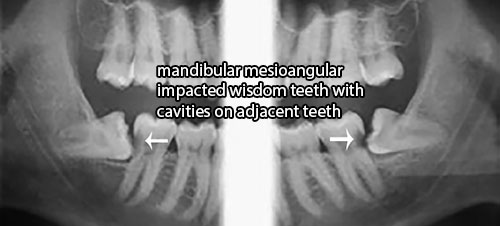An interesting article appears in the July 2015, British Dental Journal, titled “Revolution vs status quo? Non-intervention strategy of asymptomatic third molars causes harm” written by V. Toedtling and J. M. Yates (vol. 219, no. 1, pp. 11-12.) The article addresses how the Faculty of Dental Surgery of the Royal College of Surgeons of England has asked the National Institute for Health Care Excellence (NICE) to re-assess their guidance on wisdom teeth extractions. This is because the group and doctors feel that there is an increasing amount of distal-cervical caries (cavities) in lower second molar teeth (teeth right next to wisdom teeth) when associated with asymptomatic partially erupted mesial or horizontally impacted lower wisdom teeth (mandibular third molars).
The authors say that NICE has been reluctant to re-appraise their 2000 guidance and guidelines on wisdom teeth removal. The authors point out that these guidelines were based partially off of a report which refers to research that is 3 decades old (at the time of the guidance). This report showed that there is a very low rate of distal cervical caries in lower second molars (1 to 4.5% incidence). The authors say because so many wisdom teeth were prophylactically extracted during this time the true incidence remained unknown.
The authors later provide a case report of a 35 year old man who had cavities on both adjacent second molars next to mandibular mesioangular impacted wisdom teeth. They recommended extraction of both of the wisdom teeth and both of the adjacent second molars. This patient was asymptomatic and regularly saw a dentist every 6 months for follow-up. A dental panoramic tomograph was taken which is shown below. The authors feel that such an impaction is extremely difficult to clean and they have seen many similar patients who present late in the disease process and the only option is extraction.

The authors say that their own research and analysis suggests that carious second molars in association with partially erupted mandibular wisdom teeth has an incidence of 38%. The authors feel that many adult patients simply are not assessed for these types of cavities. In addition it seems the authors feel that mesial and horizontally impacted wisdom teeth should be preventatively removed. The authors state near the end of the article
“So how can patients’ quality of care and prognosis of lower second molars in the presence of asymptomatic mesially/horizontally impacted lower third molars be enhanced in this current atmosphere of debate and knowledge that contradicts current guidelines? For now clinicians have no choice but to use the tools and guidance already available as best as reasonably achievable. Namely, a rigorous caries risk assessment, biannual bitewing radiographs, individualised preventative measures and timely assessment of third molars.”
Over on the risks of keeping wisdom teeth page at http://www.teethremoval.com/risks_of_keeping_wisdom_teeth.html I have discussed how mesially/horizontally impacted wisdom teeth are the least likely to erupt so patients with such wisdom teeth should consider the risks and benefits of removal or retention.
